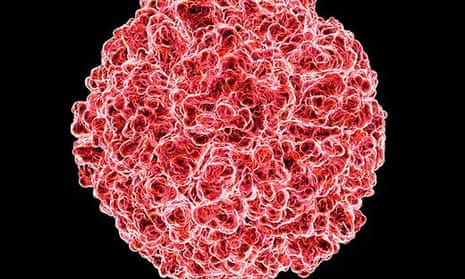It’s a conundrum that has stumped scientists for centuries, but now researchers say they have taken a tantalising step forward in the quest to tackle the common cold.
The scourge of workplace, home and school playground, the common cold is predominantly caused by the rhinovirus. But attempts to thwart the pathogen by vaccination or antiviral drugs face a number of difficulties – not least because the virus comes in many forms and can mutate rapidly leading to drug resistance.
But now scientists say they have discovered a way to nobble the virus that could one day help those with conditions such as asthma and cystic fibrosis, for whom a cold is not merely a nuisance but a serious health risk.
The trick, the authors say, is to develop drugs that interact with one of the enzymes within our cells – an approach that makes it harder for the virus to become drug-resistant.
“Viruses hijack the host to make more copies of themselves. This enzyme is one of the host enzymes that the virus hijacks,” said Roberto Solari, visiting professor at the National Heart and Lung Institute, Imperial College London, and a co-author of the study.
Writing in the journal Nature Chemistry, a team of researchers based around the UK report how they looked at molecules that interact with a human enzyme that attaches a type of fatty acid molecule on to proteins. While two of these molecules on their own had little effect on the enzyme, the team found that when they were chemically stitched together they became remarkably potent in preventing the enzyme from working as normal.
Solari said that is important, since the virus uses the enzyme to assemble the protein coat which surrounds the genetic material of the virus.
“What we found is if we block the addition of this fat, the coat doesn’t assemble so the virus doesn’t package its genes into its coat,” he said. “The virus still makes its own genes, it makes the coat, but the coat can’t assemble so the virus can’t replicate – you actually don’t make infectious particles.”
The team say the molecule appears to completely prevent the virus from replicating, whether it is added one hour before, one hour after or at the same time as the cells are infected, and that it remains effective up to three hours after infection. The approach was also found to prevent the replication of other viruses in the same family as rhinovirus – including polio and foot-and-mouth disease.
But Solari said a cure for the common cold is a long way off: the drug will need to undergo further developments and optimisation before it can be used as a medication, while tests have so far only been carried out on human cells in a dish.
“We haven’t done any animal studies, and we obviously haven’t done any studies in humans, so I can’t tell you formally what the animal toxicity of this compound is,” said Solari, adding that it is also unclear whether the approach would work by the time symptoms of a cold appear – typically a few days after infection. “There is a still a long way before this becomes a medicine,” he said.
And, even if the latest discovery does eventually lead to a way to treat colds, its use is likely to be limited to those with respiratory conditions such as asthma, chronic obstructive pulmonary disease and cystic fibrosis, for whom a catching a cold can be dangerous.
“Rhinovirus, the common cold virus, in healthy people is pretty trivial – you have the runny nose, you have a bit of a temperature, you don’t feel well for two or three days, but you get over it,” said Solari.
